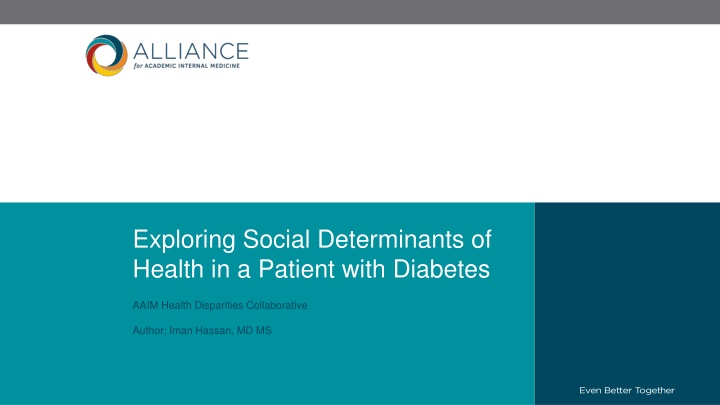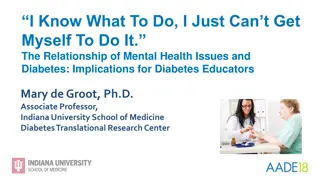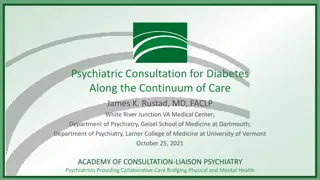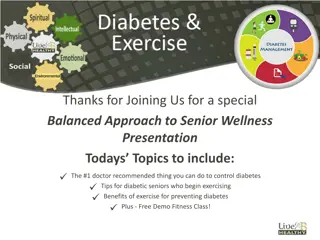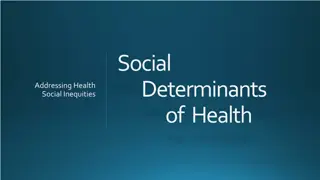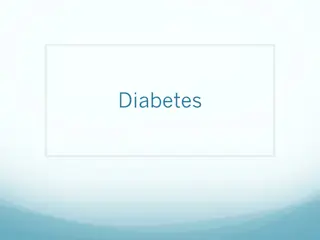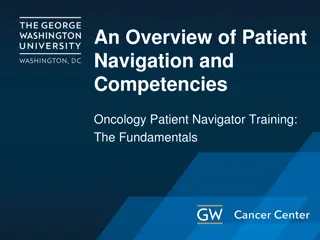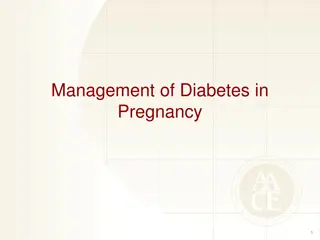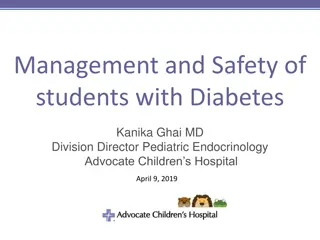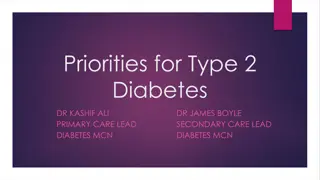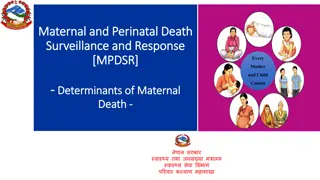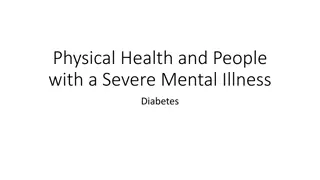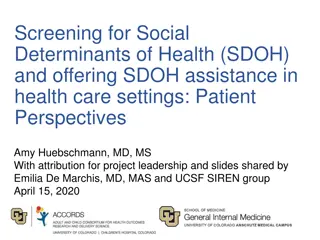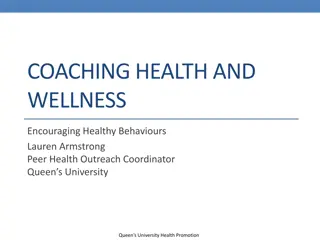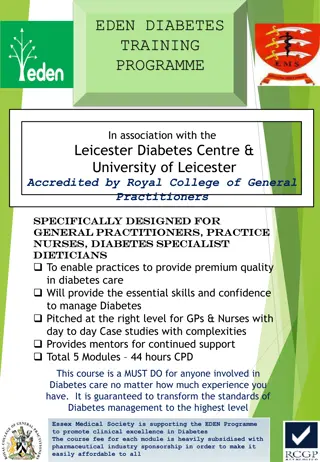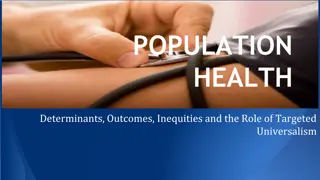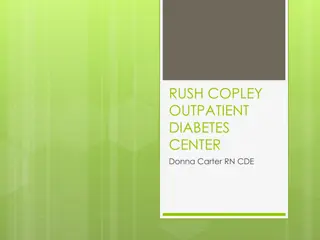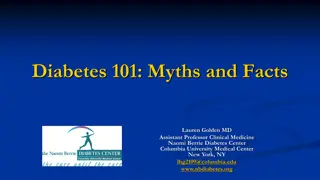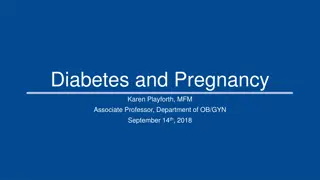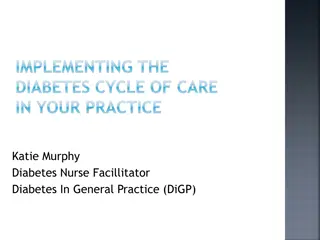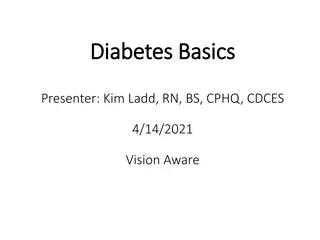Social Determinants of Health in Diabetes Patient
social determinants impacting a diabetes patient's health, address social needs pre-discharge, identify potential health insurance options. Learn about the patient's social history and available resources to improve health outcomes."
Download Presentation

Please find below an Image/Link to download the presentation.
The content on the website is provided AS IS for your information and personal use only. It may not be sold, licensed, or shared on other websites without obtaining consent from the author.If you encounter any issues during the download, it is possible that the publisher has removed the file from their server.
You are allowed to download the files provided on this website for personal or commercial use, subject to the condition that they are used lawfully. All files are the property of their respective owners.
The content on the website is provided AS IS for your information and personal use only. It may not be sold, licensed, or shared on other websites without obtaining consent from the author.
E N D
Presentation Transcript
Exploring Social Determinants of Health in a Patient with Diabetes AAIM Health Disparities Collaborative Author: Iman Hassan, MD MS
M.R. Case Learning Goals Describe available health insurance options Identify resources for primary care and medications Screen for and search resources for food insecurity Explore the neighborhood and physical environment
Case Presentation M.R. is a 37 year old woman with no diagnosed medical conditions who presents to the emergency room (ER) with fever and right flank pain. She also reports fatigue, polyuria and polydipsia for the past two months. She is diagnosed with pyelonephritis and found to have a glucose level of 398 mg/dL in the ER. After administration of fluids, insulin and antibiotics, she is admitted to your service. Her vitals are normal apart from a BMI of 33 kg/m2. A review of her lab work obtained in the ER shows an A1c of 14%, and normal creatinine and liver function tests. What social history would you like to obtain from M.R.?
Social History On further history, M.R. tells you that she does not have a primary care physician and currently has no health insurance. She lives with her mother and seven year old daughter in a neighborhood close to the hospital, the same neighborhood where she was born and grew up. She has an associates degree in management and formerly worked as an office receptionist but is currently in between jobs, helping to take care of her mother who is ill. She is currently not in a relationship and not sexually active. M.R. s older sister lives nearby. What social needs should be addressed before discharging M.R.?
At this time, for which of the following health insurance options could M.R. potentially qualify? (select all that apply) (a) Medicare (b) Medicaid (c) Affordable Care Act Marketplace Insurance (d) Children s Health Insurance Program (CHIP) (e) None of the above
At this time, for which of the following health insurance options could M.R. potentially qualify? (a) Medicare (b) Medicaid (c) Affordable Care Act (ACA) Marketplace Insurance (d) Children s Health Insurance Program (CHIP) (e) None of the above
At this time, for which of the following health insurance options could M.R. potentially qualify? (a) Medicare Medicare is a federal health insurance program for people 65+, people with End Stage Kidney Disease (ESRD) and some younger individuals with disabilities. M.R. does not qualify for this program. (b)Medicaid (c) Affordable Care Act (ACA) Marketplace Insurance (d) Children s Health Insurance Program (CHIP) (e) None of the above
At this time, for which of the following health insurance options could M.R. potentially qualify? (a) Medicare (b)Medicaid Medicaid is a state and federally funded health insurance program for low income individuals. M.R. should be screened for eligibility for this program firstas it provides the best coverage at the lowest cost. (c) Affordable Care Act (ACA) Marketplace Insurance (d) Children s Health Insurance Program (CHIP) (e) None of the above
At this time, for which of the following health insurance options could M.R. potentially qualify? (a) Medicare (b)Medicaid (c) Affordable Care Act (ACA) Marketplace Insurance The ACA was established in 2010 to provide a marketplace for individuals to purchase subsidized health insurance plans. M.R. should explore this option if she does not qualify for Medicaid. (d) Children s Health Insurance Program (CHIP) (e) None of the above
At this time, for which of the following health insurance options could M.R. potentially qualify? (a) Medicare (b)Medicaid (c) Affordable Care Act (ACA) Marketplace Insurance (d) Children s Health Insurance Program (CHIP) CHIP is a state and federal program covering children up to the age of 19 who meet certain income qualifications. M.R. does not qualify for this program.Her child may qualify if she is not insured. (e) None of the above
At this time, for which of the following health insurance options could M.R. potentially qualify? (a) Medicare (b) Medicaid (c) Affordable Care Act (ACA) Marketplace Insurance (d) Children s Health Insurance Program (CHIP) (e) None of the above Individuals without legal documentation status have difficulty obtaining health insurance and do not qualify for the above programs, with the exception of states that provide coverage to children and pregnant women regardless of documentation status. M.R. was born in the U.S. and is therefore eligible for one of the above options.
Studies have shown that having health insurance results in which of the following outcomes: (select all that apply) (a) Reduced out-of-pocket medical spending including catastrophic spending (b) Increased preventative visits (c) Decreased prescription drug utilization (d) Increased diagnosis and treatment of chronic conditions
Studies have shown that having health insurance results in which of the following outcomes: (select all that apply) (a) Reduced out-of-pocket medical spending including catastrophic spending (b) Increased preventative visits (c) Decreased prescription drug utilization (d) Increased diagnosis and treatment of chronic conditions Sommers e. al. NEJM 2017
Screening M.R. for eligibility A social worker at your hospital speaks with M.R. and determines that she is eligible for Medicaid insurance. M.R. s sister brings in necessary documentation and the application for Medicaid is submitted. You are notified that it will take at least a month to process M.R. s application. You recognize that M.R. needs close outpatient follow-up for her diabetes. What options are available for M.R. to obtain primary care while she awaits approval of her insurance?
Primary Care for Individuals without Insurance Federally Qualified Health Centers (FQHC) Provide sliding scale health care services based on ability to pay. Include federally funded Community Health Centers, Migrant Health Centers, Health Care for the Homeless, and Health Centers for Residents of Public Housing. Free or low-cost health clinics Many academic institutions and community organizations run free or low cost health clinics. What is the nearest FQHC or free/low cost health clinic to your hospital?
Medication Coverage for Individuals Without Insurance You would like to discharge M.R. on Metformin and a long acting insulin. Your hospital can provide a short term supply of medications on discharge, but she will need additional medication before her insurance is approved. What options are available to help M.R. afford her medications?
Medication Coverage for Individuals Without Insurance Free/low cost health clinics and Federally Qualified Health Centers have medication assistance programs for patients without insurance Pharmacy discount programs Websites like Goodrx.com or Needymeds.org The above programs often necessitate switching patients regimens to cheaper options. Use Goodrx.com to determine the cheapest available insulin option for patients without health insurance.
M.R. Outpatient Visit Three months later you are covering for a colleague and see M.R. for a clinic visit. She has obtained health insurance and is now on Metformin and both long acting and short acting insulin for her diabetes. Her A1c today is 10. As you review her fingerstick glucose log, you notice that while the majority of readings are in the mid 200s, she has had a few daytime hypoglycemic readings in the past week. In addition to inquiring about M.R. s insulin practices and diet, what social needs might M.R. have?
Screening for Food Insecurity (FI) FI has been shown to be associated with hypoglycemia in diabetics. Validated USDA two question screen for FI, The Hunger Vital Sign : M.R. informs you that she is sometimes worried about food running out at the end of the month before she can afford to buy more. What resources are available to address food insecurity in M.R.?
Resources for Food Insecurity Food Distribution Programs: produce distribution programs, food pantries and soup kitchens can help with immediate food needs. Supplemental Nutrition Assistance Program (S.N.A.P.): low income individuals may qualify for this program, formerly known as food stamps, to help subsidize monthly food costs. Farmers Markets: fresh, locally grown produce. Some markets accept S.N.A.P. or have food bucks programs. Use auntbertha.com to find food pantries near your clinic or hospital.
Neighborhood Resources M.R. is motivated to lose weight. In addition to considering a diabetic medication to help her lose weight, you counsel on diet and exercise modifications. M.R. informs you that she does not feel safe exercising in her neighborhood and cannot afford a gym membership at this time. You want to learn more about M.R. s neighborhood. Start by finding the walkability score for the neighborhood surrounding your clinic/hospital.
Gathering Public Health Data Explore public health data for the neighborhood surrounding your clinic or hospital. What are: - rates of poverty, food insecurity, housing problems, air pollution? - rates of poor health? - other public health data?
Neighborhoods have been shown to be independently associated with which of the following? (select all that apply) (a) Rates of Coronary Heart Disease (b) Rates of Diabetes (c) Rates of Obesity (d) Likelihood of receiving bystander initiated CPR
Neighborhoods have been shown to be independently associated with which of the following? (select all that apply) (a) Rates of Coronary Heart Disease (b) Rates of Diabetes (c) Rates of Obesity (d) Likelihood of receiving bystander initiated CPR
Neighborhood Assets In order to better assist M.R. you ask about neighborhood assets such as community centers, recreation centers, greenspace, retail spaces, religious centers, senior centers, schools, etc. Use google maps to find the nearest greenspace/recreation center. You can also use google maps to virtually explore the neighborhood surrounding your hospital/clinic. You can observe: conditions of homes/housing, conditions of roads, lighting, open spaces, public transportation, retail spaces, clinics, etc. Use auntbertha.com to locate other resources in the neighborhood that might be helpful for M.R.
Exploring Neighborhood History In addition to virtually exploring M.R. s neighborhood, you would like to learn more about the neighborhood s history. You decide to ask M.R. how it was like growing up in her neighborhood. Google the neighborhood surrounding your hospital or clinic to learn more about its history.
